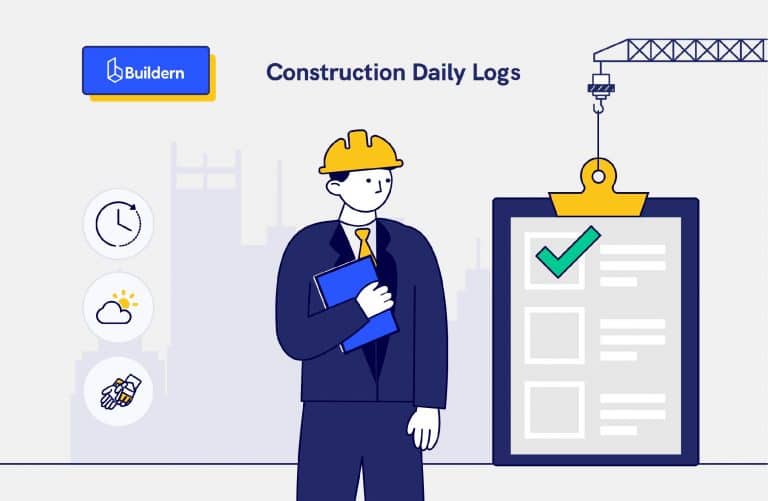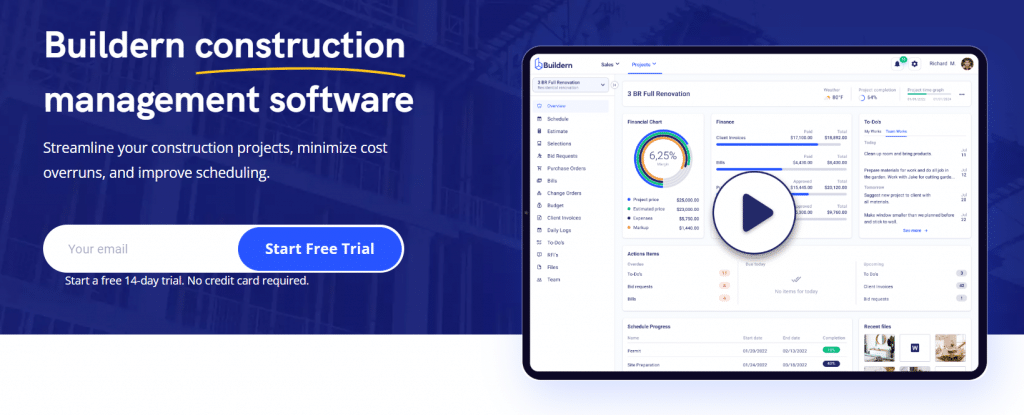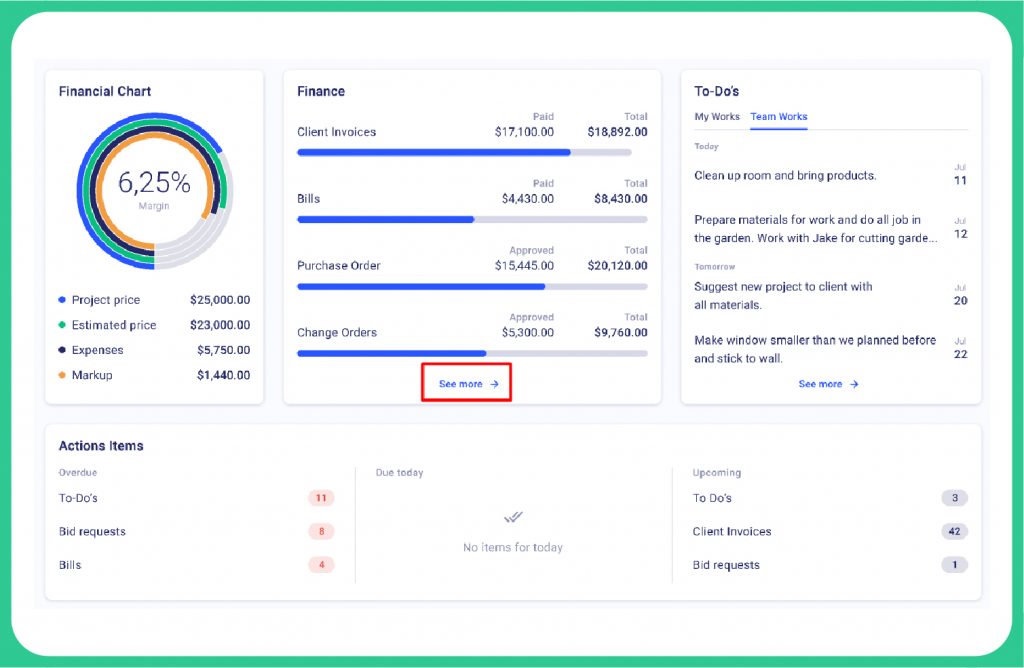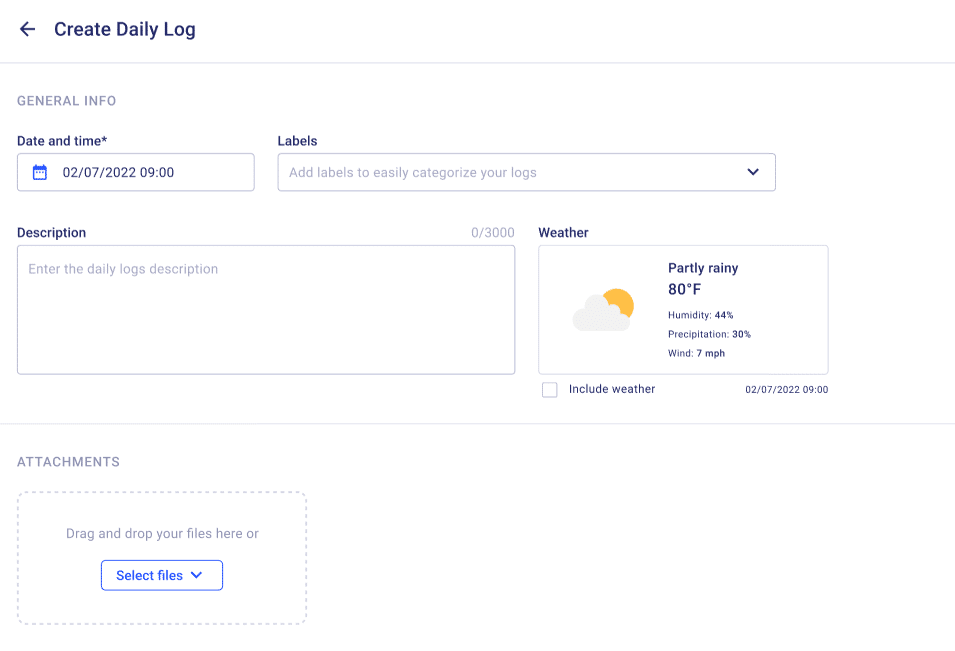Logging Progress, Driving Success: Construction Daily Logs Explained

Do you find yourself constantly battling with incomplete records, misplaced information, and missed deadlines? If so, it’s time to anchor your success with a powerful tool: construction daily logs.
In the high-stakes construction world, the importance of keeping accurate and detailed daily logs cannot be overstated. Such recordings are the backbone of project management, providing a vital record of progress, challenges, and triumphs. Daily logs connect the construction job site with the office, ensuring everyone involved in the project stays informed on the progress.
Consider this: according to a survey by KPMG, over 70% of construction projects result in cost overruns and delays, with miscommunication, poor documentation, and information issues among the major reasons.
The figures are staggering, but it doesn’t have to be your reality!
Think of construction daily logs as your project’s journal—a trusted companion that faithfully captures every detail of your construction journey. From the moment the first nail is hammered to the final touch of paint, these logs meticulously document daily activities, material usage, weather conditions, workforce attendance, and any unforeseen challenges and accidents that arise along the way.
In this article, we will delve into the depths of construction and maintenance daily logs, uncovering their true potential and how they can revolutionize your project management. We’ll explore best practices for logging progress and demonstrate how digital solutions can streamline the process.
So, grab your hard hat and get ready to navigate the waters of construction confidently!
What Are Construction Daily Logs?

In the dynamic construction field, daily construction logs are crucial in tracking and managing your project effectively. It is a detailed record that captures the essential information of each day’s activities, promoting transparency, accountability, and overall success.
A daily construction logs are a reliable tool documenting the key events and milestones achieved throughout a project. It is a comprehensive account, recording crucial details such as completed tasks, materials used, workforce attendance, equipment utilization, and weather conditions. It goes beyond surface-level information, providing valuable insights into the inner workings of your construction site.
What Is the Purpose of Having Construction Daily Logs Reported?
Now, you may wonder why dedicating time and effort to maintaining these meticulous records is important. The answer lies in the profound impact that construction daily logs have on the success of your project. By diligently recording every aspect of the construction journey, builders lay the foundation for remarkable achievements.
It is a comprehensive chronicle that encapsulates the essence of your construction site, painting a vivid picture of progress, setbacks, and triumphs along the way. By consistently documenting daily activities, material usage, workforce presence, equipment utilization, and other critical information, builders gain valuable insights into the project’s status.
Thus, having a well-developed approach to handling these recordings will help a builder keep the project running on a schedule.
However, the significance of construction daily logs extends beyond project planning and completion. They provide a historical record that can be referred to for future reference, audits, or legal purposes. These records can also serve as a valuable data source for performance analysis, enabling builders to identify areas of improvement, optimize workflows, and enhance future project outcomes.
Here are a few examples to prove to you the importance of keeping detailed records:
Accurate Documentation for Legal Protection
Detailed records act as a crucial source of evidence in the event of disputes, claims, or legal issues. By maintaining thorough documentation of activities, materials, and changes, you can protect your interests and provide a factual account of events.
Imagine a situation when a client files a claim against your work. In such cases, presenting reliable evidence can be the difference between success and failure. With comprehensive daily log records, you can prove the timeline and accuracy of your work. You may also track easier your team’s timesheets and make accurate payments.
Effective Communication and Collaboration
Detailed records facilitate clear and concise communication among project stakeholders. They serve as a reference point for discussions, enabling everyone to be on the same page regarding project progress, challenges, and decisions. This promotes effective collaboration and minimizes miscommunication.
When a team fails to coordinate its efforts, costly delays are almost inevitable. However, with a clear picture of the project’s status, builders can work together towards common goals without missteps.
Compliance with Regulations and Standards
Construction projects must often comply with various regulations, codes, and industry standards. Detailed records provide evidence of adherence to these requirements, ensuring that your project remains compliant and avoids costly penalties or delays.
Moreover, having everything documented and in order helps improve safety on the job site. Recording daily activities, weather conditions, and labor hours allows builders to identify potential risks and take timely action quickly.
How to Create a Construction Daily Report?
Builders have the flexibility to choose the format that suits them best when keeping construction records, whether it’s the traditional pen and paper or digital solutions like Excel spreadsheets.
However, relying solely on manual methods can lead to inefficiencies, lost data, and overall chaos in managing construction daily logs. That’s why embracing professional contemporary software solutions, such as Buildern, can be a game-changer for construction teams.

Automating certain processes, such as routine data entry, can save time and resources. Moreover, digital solutions provide secure storage of records and enable builders to access any data they need whenever they need it quickly. This promotes more efficient collaboration among team members and helps streamline the project management process.
Now that we have a better understanding of the matter let’s see how professional builders seamlessly integrate their construction site daily log management with Buildern’s user-centric interface.
Step 1. Sign in to your Buildern account
You should be an active Buildern user to access the complete functionality of the software. By signing in to your Buildern account, you gain access to a user-friendly interface and a range of features specifically designed to streamline construction project management.
Step 2. Select the Project
Once you have signed in to your Buildern account, you will be directed to the dashboard. Look for the project list or menu and select the specific project for which you want to create daily logs.

Each project has its separate database with all the records, documents, licenses, and other project-related stuff, including daily logs.
Step 3. Create Daily Logs Entry
In the section of the daily logs, you should see a button to start a new report. Click on it to initiate the process of creating a new record for the selected project. Buildern will guide you through the necessary steps to capture the relevant information accurately.
Step 4. Fill in the Details
Buildern provides a user-friendly interface where you can input the details of your daily report.

The platform typically offers various fields and sections to enter information, such as date and time, weather conditions, and any additional notes and labels. Fill in each field with the specific details applicable to the day’s activities.
Step 5: Add Supporting Documentation
Buildern allows you to attach and upload supporting documents to your construction reports. If you have any relevant photos, drawings, or other files that provide visual context or additional information, click on the designated option to add these files to your report. This enhances the comprehensiveness and clarity of your documentation.
Step 6: Review and Submit
Take a moment to review the entered information for accuracy and completeness before finalizing the record. Ensure all the details are entered correctly, and any attached documents are properly labeled.
Once you are satisfied with the content, tick the “Share with Client” section if you want to keep your client, informed about the progress or leave it private only to team members.
Buildern will store your report securely in the system, making it easily accessible for future reference, analysis, or sharing with project stakeholders.
By following these steps in Buildern, you can efficiently create detailed and organized construction logs. The platform’s intuitive features streamline the process, saving you time and providing valuable insights into your construction project.

Key Sections to Include in Construction Logs
When creating a comprehensive daily report it is important to include sections that capture essential information related to the project. These sections provide a structured framework for documenting and organizing crucial details.
Let’s dig deeper to help you understand the matter better.
Project Information
Start the construction logs by including relevant project details, such as the project name, location, client information, project manager, and any other pertinent identifiers. This section helps provide context and ensures easy reference.
However, you can omit this part if you create your logs via Buildern. The software ensures all logs are perfectly organized across projects.
Weather Conditions
Accurate documentation of prevailing weather conditions is vital in construction field reporting. It provides crucial insights into how weather factors impact various aspects of the project, including progress, safety, and resource allocation. Include detailed information such as temperature, humidity, wind speed, precipitation, and visibility.
Additionally, note any weather-related incidents, such as rain delays or heat stress precautions taken. By thoroughly documenting weather conditions, project stakeholders can better understand the project’s performance and make informed decisions to mitigate weather-related risks.
Daily Activities
Maintaining a comprehensive record of daily activities is essential for effective project management. In this section, provide a meticulous account of the tasks and activities performed on the construction site during each day. Include specific details about the work completed, resources utilized, and the sequence of tasks.
This section serves as a valuable reference for tracking progress, identifying productivity trends, and evaluating the overall project performance. By documenting daily activities in a detailed and organized manner, project managers can monitor project timelines, allocate resources efficiently, and proactively address any deviations from the project plan.

Workforce and Labor
Document the number of workers present each day, including subcontractors, and specify their trade specialties or roles. Additionally, capture relevant details related to labor productivity, such as the number of hours worked, output achieved, and any challenges faced.
This information helps in evaluating workforce allocation, identifying skill requirements, and addressing any labor-related issues that may impact project progress.
Equipment and Machinery
Thoroughly document the utilization of equipment, machinery, and vehicles on the construction site. Include comprehensive details such as the type of equipment used, hours of operation, maintenance activities performed, and any incidents or malfunctions encountered.
This record provides valuable insights into equipment performance, usage patterns, and maintenance requirements. Additionally, note any safety protocols followed when operating equipment. Accurate documentation of equipment-related information enables effective equipment management, facilitates preventive maintenance planning, and helps ensure compliance with safety standards.
Materials and Supplies
Include essential details such as quantities received, suppliers’ information, and dates of material inspections. Accurate documentation of materials and supplies ensures transparency in the construction process and facilitates effective inventory management. This information helps in tracking material usage, estimating project costs, and identifying any potential material-related risks.
By diligently recording materials and supplies data, project managers can proactively address procurement challenges, ensure timely availability of resources, and maintain quality standards throughout the project lifecycle.
Safety Incidents and Near Misses
Devote a dedicated section in the construction logs to record any safety incidents, accidents, or near misses that transpire during construction activities. Document the nature of the incident, including the type of hazard involved and the individuals affected. Include relevant information such as the date, time, and location of the incident. Describe the actions taken to address the situation, such as first aid administered, reports filed, or emergency protocols activated.
Furthermore, outline the preventive measures implemented to avoid similar incidents in the future, including safety training, equipment modifications, or policy enhancements. By thoroughly documenting safety incidents and near misses, project stakeholders can identify trends, implement corrective measures, and foster a culture of continuous improvement in safety protocols.
Communication and Meetings
Incorporate a dedicated section succinctly summarizes critical communication exchanges, meetings conducted, and decisions made throughout the project. Include details such as the date, participants, agenda, and key outcomes of each communication event or meeting.
This section serves as a centralized record of important discussions, instructions given, and changes to the project scope or timeline.
Additionally, document any follow-up actions or agreements resulting from these communications. By meticulously capturing communication and meeting information, project managers can ensure alignment among team members, track project-related decisions, and maintain a transparent record of project communication history.

Challenges and Solutions
Maintain a comprehensive logs of the challenges, obstacles, and issues encountered during the construction process. Provide detailed descriptions of each problem, including its impact on the project, the parties involved, and the timeline of its occurrence. Document the steps taken to resolve or mitigate each challenge, emphasizing the strategies employed and the resources allocated.
This section should showcase the project team’s proactive problem-solving abilities and provides valuable insights for future reference.
Progress and Milestones
Maintain an up-to-date record of the overall progress made on the project, highlighting significant milestones achieved or completed phases. Include specific details such as dates, accomplished deliverables, and noteworthy accomplishments.
This section should provide a concise overview of the project’s advancement and facilitates tracking progress against the project schedule. By documenting progress and milestones, project stakeholders can evaluate project performance, identify potential bottlenecks, and ensure that the project is on track to meet its objectives.
5 Best Practices for Successful Construction Daily Logs Management
Managing construction daily logs effectively is crucial for the success of any construction project. By implementing best practices in construction daily logs management, you can streamline processes, enhance communication, and ensure accurate and accessible records.
Here are 5 expert tips to help you achieve successful construction daily logs management:
Consistent and Timely Documentation
Maintain a disciplined approach by consistently documenting daily activities, incidents, and important details in the construction daily logs. Encourage all team members to provide their inputs promptly, ensuring that information is captured accurately and in a timely manner. Consistency and timeliness in documentation help avoid information gaps, memory lapses, and ensure the integrity of the construction logs.
Clear and Detailed Entries
Provide clear and detailed entries in the construction daily logs. Clearly describe the activities performed, including the work completed, resources utilized, and any notable observations or milestones achieved. Use specific terminology and avoid ambiguous or vague language to ensure that the information recorded can be easily understood by all project stakeholders.
Organized Categorization and Cross-Referencing
Implement an organized categorization system for different sections of the construction daily logs. Use consistent headings, subheadings, and labels to categorize information effectively. Additionally, establish cross-referencing mechanisms to link related entries across different sections of the log. This allows for quick retrieval of information and facilitates comprehensive analysis and reporting.
Utilize Technology and Digital Solutions
Leverage modern technology and digital solutions to streamline construction daily log management. Consider using construction management software or mobile applications specifically designed for construction daily reporting. These tools offer features such as automated data entry, real-time collaboration, and synchronization across devices. Digital solutions help minimize manual errors, enhance data accuracy, and provide easy access to construction daily logs for all project stakeholders.
Regular Review and Communication
Regularly review the construction daily logs with the project team and stakeholders. Conduct periodic meetings or discussions to ensure that everyone is aware of the recorded information and address any questions or discrepancies. Effective communication about the construction daily log helps foster transparency, accountability, and collaborative decision-making. Regular reviews also enable the identification of trends, patterns, and opportunities for process improvement.
Final Observations
As construction professionals, we understand the challenges of managing construction daily logs and the impact it has on the success of our projects. How many times have important details been overlooked or lost, leading to delays, disputes, or costly rework?
The importance of keeping accurate and comprehensive construction daily logs cannot be overstated. These logs are the heartbeat of our projects, capturing the journey from start to finish, documenting progress, challenges, and triumphs.
To streamline this process and ensure seamless log management, consider leveraging the power of modern technology. Buildern, a leading construction project management software, offers robust features designed to automate construction daily logs, synchronize team members with real-time updates, and provide a centralized platform for efficient project communication. With Buildern, you can bid farewell to the chaos of scattered papers and embrace a digital solution that empowers you to drive success in your construction projects.
Take control of your construction daily logs and unleash the full potential of your projects with Buildern today!



